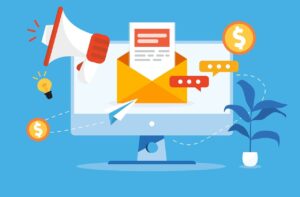Email Marketing: The Secret to Converting Clicks into Customers
In the ever-evolving landscape of digital marketing, Email Marketer remains one of the most powerful and cost-effective tools to connect with your audience, build trust, and drive conversions. While social media platforms rise and fall in popularity, email remains a consistent and direct line of communication between a business and its potential or existing customers.
Email marketing is more than just sending newsletters. It is a strategic communication tool that allows businesses to directly reach their target audience with personalized messages. Unlike social media platforms that rely on algorithms, email ensures that your content reaches your subscriber’s inbox directly.
What Makes Email Marketing So Effective?
Email marketing is more than just sending newsletters. It is a strategic communication tool that allows businesses to directly reach their target audience with personalized messages. Unlike social media platforms that rely on algorithms, email ensures that your content reaches your subscriber’s inbox directly.
Why Email Marketing Still Matters
Despite the rise of newer marketing channels, email marketing offers unique advantages:
-
Direct Access: Unlike social media algorithms, emails land directly in the recipient’s inbox.
-
High ROI: According to studies, email marketing generates an average ROI of $36 for every $1 spent.
-
Personalization: With the help of automation tools, businesses can deliver highly personalized content.
-
Automation: You can set up workflows to nurture leads even while you sleep.
-
Ownership: Unlike followers on social media, your email list is entirely owned by you.

Key Components of a Successful Email Marketing Campaign
-
Building a Quality Email List
Your success begins with having the right audience. Use lead magnets such as eBooks, discount offers, or exclusive content to encourage people to subscribe. -
Segmentation and Targeting
One-size-fits-all emails often lead to low engagement. -
Crafting Compelling Subject Lines
The subject line is your first impression. -
Valuable Content
The content inside the email should provide value—whether it’s educational, promotional, or informative. -
Responsive Design
Ensure your emails are mobile-friendly. A large portion of users read emails on smartphones, so your design must adapt accordingly. -
Testing and Optimization
A/B test your subject lines, CTAs, images, and layout to understand what works best. Use analytics to improve future campaigns.
Types of Email Campaigns You Can Use
-
Welcome Emails: First impression emails to introduce your brand.
-
Promotional Emails: Highlight discounts, sales, or product launches.
-
Newsletter Emails: Regular updates about your content, company, or industry trends.
-
Transactional Emails: Order confirmations, shipping details, etc.
-
Re-engagement Emails: Designed to win back inactive subscribers.
Best Practices for Effective Email Marketing
-
Always get permission before sending emails (use double opt-in methods).
-
Include a clear unsubscribe link in every email.
-
Avoid spammy words like “Buy Now”, “Free $$$”, or “Make Money Fast”.
-
Send emails consistently but don’t overwhelm your subscribers.
-
Monitor metrics like open rate, click-through rate, and bounce rate regularly.
Conclusion
Email marketer is far from outdated—when done right, it’s one of the most powerful assets in any digital marketer’s toolbox. It allows brands to nurture relationships, build trust, and convert leads into loyal customers at a minimal cost. Whether you’re a freelancer, small business owner, or digital marketing specialist, mastering email marketing can significantly improve your online performance.
If you’re looking to boost your business through high-converting email strategies, don’t hesitate to get in touch—I can help you craft tailored campaigns that deliver real results.
